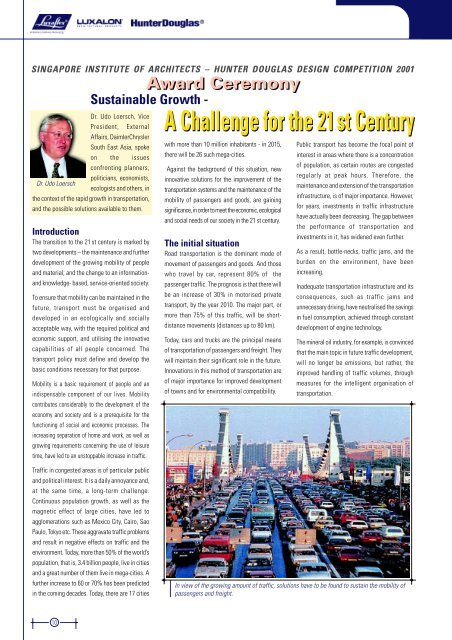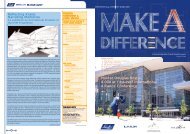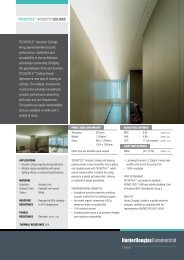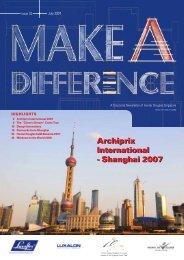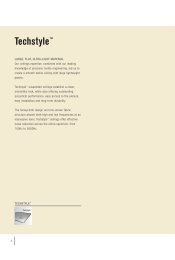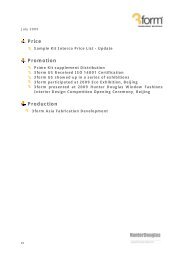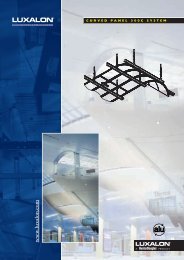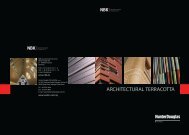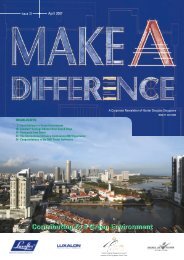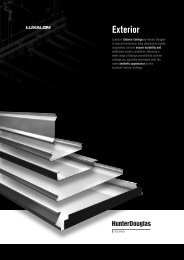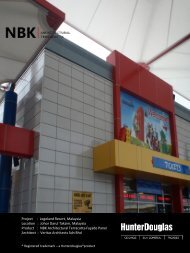SINGAPORE INSTITUTE OF ARCHITECTS – HUNTER DOUGLAS DESIGN COMPETITION 2001Dr. Udo Loersch, VicePresident, ExternalAffairs, DaimlerChryslerSouth East Asia, spokeon the issuesconfronting planners,politicians, economists,Dr. Udo Loerschecologists and others, inthe context of the r<strong>ap</strong>id growth in transportation,and the possible solutions available to them.IntroductionThe transition to the 21 st century is marked bytwo developments – the maintenance and furtherdevelopment of the growing mobility of peopleand material; and the change to an informationandknowledge- based, service-oriented society.To ensure that mobility can be maintained in thefuture, transport must be organised anddeveloped in an ecologically and sociallyacceptable way, with the required political andeconomic support, and utilising the innovativec<strong>ap</strong>abilities of all people concerned. Thetransport policy must define and develop thebasic conditions necessary for that purpose.Mobility is a basic requirement of people and anindispensable component of our lives. Mobilitycontributes considerably to the development of theeconomy and society and is a prerequisite for thefunctioning of social and economic processes. Theincreasing separation of home and work, as well asgrowing requirements concerning the use of leisuretime, have led to an unstoppable increase in traffic.<strong>Award</strong> <strong>Ceremony</strong>Sustainable Growth -A Challenge for the 21 st Centurywith more than 10 million inhabitants - in 2015,there will be 26 such mega-cities.Against the background of this situation, newinnovative solutions for the improvement of thetransportation systems and the maintenance of themobility of passengers and goods, are gainingsignificance, in order to meet the economic, ecologicaland social needs of our society in the 21 st century.The initial situationRoad transportation is the dominant mode ofmovement of passengers and goods. And thosewho travel by car, represent 80% of thepassenger traffic. The prognosis is that there willbe an increase of 30% in motorised privatetransport, by the year 2010. The major part, ormore than 75% of this traffic, will be shortdistancemovements (distances up to 80 km).Today, cars and trucks are the principal meansof transportation of passengers and freight. Theywill maintain their significant role in the future.Innovations in this method of transportation areof major importance for improved developmentof towns and for environmental compatibility.Public transport has become the focal point ofinterest in areas where there is a concentrationof population, as certain routes are congestedregularly at peak hours. Therefore, themaintenance and extension of the transportationinfrastructure, is of major importance. However,for years, investments in traffic infrastructurehave actually been decreasing. The g<strong>ap</strong> betweenthe performance of transportation andinvestments in it, has widened even further.As a result, bottle-necks, traffic jams, and theburden on the environment, have beenincreasing.Inadequate transportation infrastructure and itsconsequences, such as traffic jams andunnecessary driving, have neutralised the savingsin fuel consumption, achieved through constantdevelopment of engine technology.The mineral oil industry, for example, is convincedthat the main topic in future traffic development,will no longer be emissions, but rather, theimproved handling of traffic volumes, throughmeasures for the intelligent organisation oftransportation.Traffic in congested areas is of particular publicand political interest. It is a daily annoyance and,at the same time, a long-term challenge.Continuous population growth, as well as themagnetic effect of large cities, have led toagglomerations such as Mexico City, Cairo, SaoPaulo, Tokyo etc. These aggravate traffic problemsand result in negative effects on traffic and theenvironment. Today, more than 50% of the world’spopulation, that is, 3.4 billion people, live in citiesand a great number of them live in mega-cities. Afurther increase to 60 or 70% has been predictedin the coming decades. Today, there are 17 citiesIn view of the growing amount of traffic, solutions have to be found to sustain the mobility ofpassengers and freight.10
SINGAPORE INSTITUTE OF ARCHITECTS – HUNTER DOUGLAS DESIGN COMPETITION 2001<strong>Award</strong> <strong>Ceremony</strong>Approaches for solutionsIn view of the growing amount of traffic andscarce financial resources, the question ofintelligent and innovative solutions that areeconomical and ecological, for the sustainablemobility of passengers and freight, has arisen.Possible measures include traffic avoidance, citydevelopment, traffic transfer, technicalinnovation, transport telematic systems andimproved traffic management systems.Traffic avoidanceTraffic avoidance is the most efficient way toreduce the burden on traffic and environment.Possible measures to achieve this includeintelligent city development, advancedinformation technology (Internet, e-commerce,home offices), reduction of empty runs or betterutilisation of passenger cars and commercialvehicles, avoidance of unnecessary driving (forexample, parking, loading/unloading), andmodern transportation telematics.City developmentWith the help of integrated transport models,scientists were able to find out the relationshipbetween the development processes in the fieldsof transportation, population, economics andenvironment.Furthermore, the world conference ‘Habitat II’1996 in Istanbul resulted in new findingsconcerning the correlation between settlementstructure and traffic. Points to consider areinterconnection of home, work and leisure time;decentralised concentration; increasedaccessibility; creation of typical districts; supportof supply and leisure facilities near residentialareas; and creation of a sufficient socialinfrastructure in the residential areas.Traffic transferThrough the linking of the different transport modes,the individual strengths of, and the free c<strong>ap</strong>acity in,each system can be utilised for more efficientmovement of passengers and freight. Relevanttopics include intelligent networking of trafficsystems, hierarchical systems of transport networksand junctions, creation of multimodal transportchains, development of logistics centres (freight andIntelligent traffic transfer between different transportation systems.transfer centres), creation of innovative transloadingsystems, and standardisation of information andcommunications systems.Technological innovationThere is high expectation that environmentallycompatible means of transportation, will bedeveloped. Additionally, research anddevelopment in the vehicle industry isconcentrated on the preservation of resourcesand the use of renewable energy sources. Theresearch is focused on energy-saving propulsiontechnologies; the use of renewable energysources (fuel cells); increased safety; vehicleswith intelligent systems; internet communicationfrom within the vehicle; and technology foradvanced control, management and safety inroad transportation.Engineers are also concentrating on reducing theemissions from, and the noise generated by,moving vehicles.Transport telematics systemsIn the control of growing traffic flows, informationtechnology is gaining great importance.Telematics, a concept which combinestelecommunications and informatics, is employedto link traffic data in an intelligent manner.Examples of telematics products are automaticguidance systems, satellite navigation systems,dynamic autopilot systems for the optimisationof routes, intelligent traffic guidance systems(ITGS), floating car data (FCD), automaticemergency call systems, terminal managementsystems, and theft pursuit systems.Although it cannot replace transportinfrastructure, telematics can considerablycontribute to a more efficient exploitation oftraffic c<strong>ap</strong>acities and potentials.Traffic management systemsNew traffic management systems for individualand public transport, optimise the processes andensure the efficient transportation of passengersand freight. These include computer-controlledmanagement systems, parking guidance systemsfor the management of parking areas, intelligenttraffic control systems, danger detection systems(for rain, fog, ice), interference management, andelectronic toll collection.The DaimlerChrysler GroupAfter the fall of the Berlin Wall, theredevelopment of the city involved some of thebiggest names in contemporary architecture.Among the key investors that have facilitated thespectacular architecture of Potsdamer Platz, andthereby contributed to the transformation ofBerlin to a 21st century city, is theDaimlerChrysler Group, a leading manufacturerof products and services for transportation,including cars, buses, trucks, and large enginesfor ships. The Group also has the competence todevelop advanced intelligent traffic concepts, tobetter organise traffic and maintain mobility.At Your ServiceFor more information, please call 849845411


